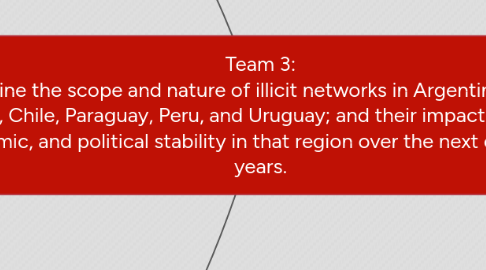
1. Scope / Nature Overlap
1.1. Corruption factor
1.2. Violence level of group
1.3. Connections
1.3.1. Internal
1.3.1.1. Gangs
1.3.2. External
1.3.2.1. Other TOC organizations / networks
1.3.2.2. Cartels
1.3.2.3. Terrorists
2. Nature
2.1. Type
2.1.1. Gang
2.1.2. Cartel
2.1.3. Terrorist
2.1.4. Specialized criminal organization
2.1.4.1. Money laundering
2.2. Activities
2.2.1. Activity types
2.2.1.1. Drugs, by type
2.2.1.1.1. Production
2.2.1.1.2. Trafficking
2.2.1.1.3. Dealing
2.2.1.2. Human trafficking
2.2.1.2.1. Sexual exploitation
2.2.1.2.2. Labor exploitation
2.2.1.3. Human smuggling
2.2.1.4. Arms trafficking
2.2.1.5. Counterfeit goods
2.2.1.5.1. Piracy
2.2.1.5.2. Money
2.2.1.6. Environmental crimes
2.2.1.7. Illegal resource harvesting
2.2.1.7.1. Illegal mining
2.2.1.7.2. Illegal logging
2.2.1.8. Financing
2.2.1.8.1. Money laundering
2.2.1.9. Extortion
2.2.1.10. Fraud
2.2.1.11. Terrorism
2.2.1.12. Other?
2.2.2. M.O of activities / operations
2.2.2.1. Drug trafficking
2.2.2.1.1. Air
2.2.2.1.2. Land
2.2.2.1.3. Sea
2.2.2.2. Human trafficking
2.2.2.2.1. Prey on poor
2.2.2.2.2. Relocate victims within country
2.2.2.2.3. Relocate victims to other countries
3. Scope
3.1. Time
3.1.1. Organizational start
3.1.2. Organizational growth / expansion
3.1.3. Future projection
3.2. Geographic
3.2.1. Region
3.2.1.1. How many different networks
3.2.1.2. Percent of region under control
3.2.2. Country
3.2.2.1. Percent of country under control
3.2.2.2. Strongholds
3.2.2.3. Areas of control
3.3. Influence / Penetration
3.3.1. Government
3.3.1.1. Quality
3.3.1.1.1. Placement of influence / corruption
3.3.1.2. Quantity
3.3.1.2.1. Amount of influence / corruption
3.3.1.3. See "Political" sub-heading under "Impact" heading
3.3.2. Society
3.3.2.1. Quality
3.3.2.1.1. severity effect on society
3.3.2.2. Quantity
3.3.2.2.1. amount of effect on society
3.3.2.3. See "Social" sub-heading under "Impact" heading
3.3.3. M.O of activities and operations
4. Impact
4.1. Political
4.1.1. Corruption
4.1.1.1. Judiciary
4.1.1.2. Law enforcement
4.1.1.3. Legislature
4.1.1.3.1. Relationship with political party
4.1.1.4. Executives
4.1.1.5. Military
4.1.1.6. See "Influence / Penetration" sub-heading under "Scope" heading
4.1.2. Government effectiveness
4.1.2.1. Maintaining order
4.1.2.2. Combatting illicit networks
4.1.2.2.1. Actively combatting
4.1.2.2.2. Partial effort to combat
4.1.2.2.3. Ignore / does not combat
4.1.3. Transparency
4.1.3.1. Polity IV
4.1.3.2. Transparency International
4.2. Social
4.2.1. Government social programs to fight networks
4.2.1.1. Quality
4.2.1.2. Quantity
4.2.2. Drug use in society
4.2.3. Family / community degradation
4.2.4. Social disorder
4.2.4.1. Riots
4.2.4.2. Strikes
4.2.4.3. Lynchings
4.2.5. Reach into society
4.2.5.1. Charity organizations
4.2.5.2. Occurrence of violence
4.2.6. Perceived safety of citizens
4.3. Economic
4.3.1. Poverty levels
4.3.2. Shadow economy vs GDP
4.3.3. Property values
4.3.3.1. Illicit network asset conversion to real estate?
4.3.4. Cost to industry
4.3.4.1. Illegal operations

